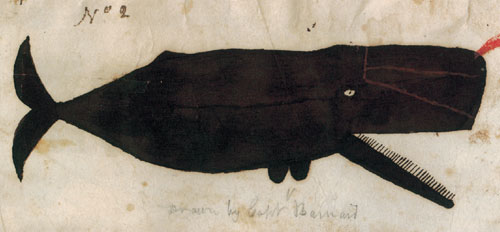Short takes on three books
By Greg Ross, Amos Esty, Tony Miksanek
Trying Leviathan • What Have You Changed Your Mind About? • The Lost Art of Walking
Trying Leviathan • What Have You Changed Your Mind About? • The Lost Art of Walking

DOI: 10.1511/2009.77.172
TRYING LEVIATHAN: The Nineteenth-Century New York Court Case That Put the Whale on Trial and Challenged the Order of Nature. D. Graham Burnett. Princeton University Press, $29.95.
In 1818, a jury in New York City took up the question of whether whales were fish. Of course not, testified prominent naturalist Samuel Mitchell, they are mammals: “I can say positively that a whale is no more a fish than a man.” On the contrary, argued the opposing side’s lawyers, pointing out the implications of this classification for the jurors: “Is not man strangely mated or matched, when the whale and porpoise are his second cousins?”

From TRYING LEVIATHAN: The Nineteenth-Century New York Court Case That Put the Whale on Trial and Challenged the Order of Nature.
The issue arose as a result of a dispute over the meaning of a New York statute that required fish oil to be inspected before it was sold. Samuel Judd, a successful oil merchant, claimed that because whales were not fish, whale oil should not count as fish oil, and he therefore refused to pay for the inspection of three casks of spermaceti oil. Not surprisingly, the inspector, James Maurice, disagreed with Judd’s taxonomy.
In Trying Leviathan, D. Graham Burnett links the case of Maurice v. Judd to a number of important cultural and social issues, but he consciously avoids depicting the story as a battle between learned men of science and the ignorant masses. Instead, he uses the trial as an epistemological exercise: How could Americans know at the time that whales were not fish? Who had the authority to make such a classification? How does scientific knowledge become conventional wisdom? Burnett’s examination of these questions makes for one of the most intellectually rigorous fish stories ever told.—Amos Esty
WHAT HAVE YOU CHANGED YOUR MIND ABOUT? Today’s Leading Minds Rethink Everything. Edited by John Brockman. Harper Perennial, $14.95, paper.
In 1997, literary agent John Brockman launched Edge.org, a Web site that pledges “to seek out the most complex and sophisticated minds, put them in a room together and have them ask each other the questions they are asking themselves.” The site has become a sort of online salon, devoted to discussion and debate among leading intellectuals in science and technology.
To help stimulate discussion, Brockman has begun posing a new question each year. These have ranged from “What are you optimistic about?” to “What is your dangerous idea?” Last year’s question, “What have you changed your mind about?,” brought a typically brilliant array of brief essays, by turns provocative, playful and profound. Brockman has collected them into a volume with the question as its title.
In one of the essays, MIT quantum-mechanical engineer Seth Lloyd describes how his students have given him a new appreciation of technology. In another, mathematician Keith Devlin explains his growing conviction that human mathematics is peculiar to the human mind. Nature news editor Oliver Morton has abandoned his support for human spaceflight. And journalist Charles Seife, who once assumed that democracy and science shared the same ideals, now believes that the egalitarian and the skeptic are natural opponents.
These contributions are typically only two or three pages long, which makes them compulsively readable. The only disappointment is that there’s no discussion among the participants—but that’s what the Web site is for.—Greg Ross
THE LOST ART OF WALKING: The History, Science, Philosophy, and Literature of Pedestrianism. Geoff Nicholson. Riverhead Books, $24.95.
Our feet don’t get nearly the respect they deserve. After reading The Lost Art of Walking, you’ll never again take your lower extremities (or the act of ambulation) for granted. Written chiefly as a memoir of the author’s walking life, this entertaining book is stuffed with anecdotes about famous walkers, great feats of bipedalism and surprising facts. For instance, of the 70,000 pedestrians who are injured by cars every year in the United States, 15,000 live in New York City.
The book contains an interesting discussion of the development of bipedalism and an intriguing section on psychogeography, but in general it skimps on the science and is heavily tilted toward the lore of walking. Some of the advantages of walking, according to Nicholson, are that it’s a cheap and environmentally friendly method of transportation, and it’s good for one’s physical and mental health. (It is not a particularly good way to lose weight rapidly, though: A 180-pound man would need to walk about 35 miles at a speed of four miles per hour to drop a single pound of body fat.) Potential hazards include feisty canines, unfriendly terrain, blistered feet and wayward automobiles. The greatest danger might be the possibility of a hard fall on concrete.
Nicholson notes that the many different speeds, strides and geometries of ambulation are reflected in the large number of synonyms for the word walk. Some are tough terms—trek, slog and tread—whereas others seem dainty—saunter and meander.
Although The Lost Art of Walking occasionally loses its footing, the book succeeds in transforming a mundane mode of locomotion into something wondrous and inspiring. All that’s missing is a complementary pedometer.—Tony Miksanek
Click "American Scientist" to access home page
American Scientist Comments and Discussion
To discuss our articles or comment on them, please share them and tag American Scientist on social media platforms. Here are links to our profiles on Twitter, Facebook, and LinkedIn.
If we re-share your post, we will moderate comments/discussion following our comments policy.